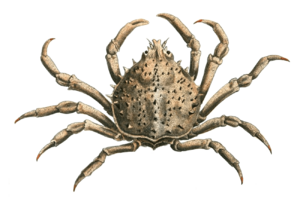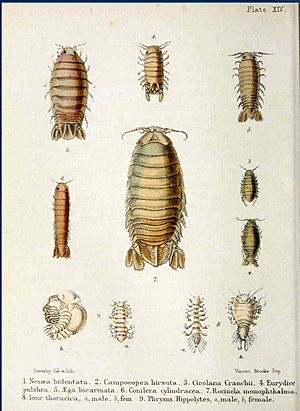William Elford Leach facts for kids
Quick facts for kids
William Elford Leach
|
|
|---|---|
| Born | 2 February 1791 Plymouth, Devon, England
|
| Died | 25 August 1836 (aged 45) San Sebastiano Curone, Italy
|
| Scientific career | |
| Fields | Natural history, entomology, marine biology |
William Elford Leach (born February 2, 1791 – died August 25, 1836) was an important English zoologist and marine biologist. He was known for his work with animals that live in the sea. He also helped to modernize how scientists studied animals in Britain.
Contents
William Leach's Early Life and Studies
William Elford Leach was born in Plymouth, England. His father was a lawyer. When William was just 12 years old, he started learning about medicine. He studied anatomy (how bodies are built) and chemistry.
Even at a young age, William loved collecting sea animals. He found them in Plymouth Sound and along the Devon coast. At 17, he went to London to study medicine further. He finished his training at the University of Edinburgh. He later earned a medical degree from the University of St Andrews.
Working at the British Museum
From 1813, Leach decided to focus on his passion: zoology. He got a job at the Natural History Department of the British Museum. His job was to look after the museum's animal collections.
Leach worked very hard to organize and update these collections. Many of them had been neglected for a long time. In 1815, he published the first list of books about entomology (the study of insects). He also studied and wrote about many other animals. These included invertebrates (animals without backbones), amphibians, reptiles, mammals, and birds.
He was the first naturalist to separate centipedes and millipedes from insects. He gave them their own group called Myriapoda. During his time, he was the world's top expert on Crustacea (like crabs and lobsters). He talked with scientists all over Europe and in the United States. In 1816, when he was only 25, he became a member of the Royal Society. This was a big honor for scientists.
Later Life and Legacy
In 1821, Leach became very ill due to working too much. He could no longer continue his research. He left the museum in 1822. His older sister, Jane, took him to Europe to help him get better. They lived in Italy and for a short time in Malta. Sadly, he died from cholera in Italy on August 25, 1836.
A scientist named Dr. Francis Boott wrote about Leach in 1837. He said that few people had worked as hard in zoology as Dr. Leach. He also said that Leach became very famous early in his life as a deep thinker about nature.
How Leach Changed Zoology in Britain
Leach's biggest impact was helping to modernize British zoology. Before him, the study of animals in Britain had not changed much. This was especially true during the long wars with France.
British zoologists still used an old system for classifying animals. This system was created by Carl Linnaeus in the 1700s. It was a good tool, but it sometimes grouped animals together in ways that didn't make sense. For example, Linnaeus grouped all animals with a hard outer skeleton as "insects." This meant butterflies were grouped with lobsters, scorpions, spiders, and centipedes. But these animals look very different and live in different ways.
In Europe, scientists started to change how they grouped species. They looked at more features, not just one or two. They began to find groups of species that looked alike, lived in similar ways, and were found in similar places. They called this the "natural method" of classification.
Leach was different from many British scientists. He knew about these new ideas from Europe. He read French scientific papers and wrote to zoologists in Paris. He used these new ideas in his own research. He also shared them with other British zoologists through his writings. Between 1813 and 1830, he wrote over 130 scientific articles and books. By using the natural method, he created more than 380 new groups of animals. Many of these groups are still used by scientists today.
Leach's Impact on Future Scientists
In 1834, a report said that zoology in Britain had been stuck for many years. It said that British scientists were too attached to Linnaeus's old system. The report gave credit to Dr. Leach for opening the eyes of English zoologists. He helped them see how important the new ideas from France were.
Two years later, the British government looked into how the British Museum was run. During this investigation, scientists confirmed Leach's importance. They said he was the first to show English scientists the progress being made in other countries. This gave a new push to zoology in Britain. Before Leach, zoology was not very popular in Britain.
Thanks to Leach, British zoology caught up with the rest of the world. He set the stage for the next generation of British zoologists. This group included famous scientists like Charles Darwin and Alfred Russel Wallace.
Even though he had a big impact, William Elford Leach is mostly remembered today through the names of animals. Many species are named after him. For example, Anolis leachii and Rhacodactylus leachianus are two types of lizards.
He is also honored in the common names of several animals. The Leach's storm-petrel (a type of seabird) was named after him in 1820. The blue-winged kookaburra is also known as Leach's kookaburra. Leach himself created the group Dacelo for kookaburras in 1815.
How Leach Named Animals
Leach often used personal ways to name new species. For example, he named 19 species and one group of animals after his friend and helper, John Cranch. Cranch had died while collecting these animals in Africa.
Leach also named nine groups of animals after an unknown woman named Caroline. He used different spellings or mixed up the letters of her name. For example, he used Carolina (a Latin form of Caroline) and anagrams like Cirolana, Conilera, and Rocinela. One example is the marine crustacean Cirolana cranchi. He named this animal in 1818 after both Caroline and Cranch.
See also
 In Spanish: William Elford Leach para niños
In Spanish: William Elford Leach para niños
- Category:Taxa named by William Elford Leach



